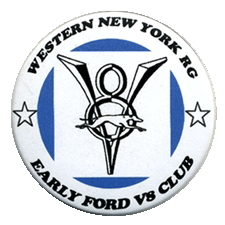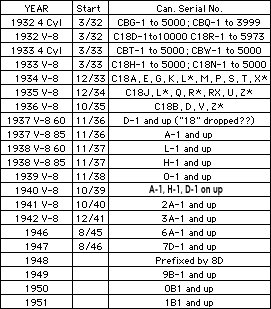
Western NY Early Ford V-8 Club - RG No. 3
Dedicated to 1932 - 1953 Ford Products
CANADIAN FORD SERIAL #S

“Oh Canada!”
It’s a VIN - VIN Situation
by Frank Scheidt
Henry Ford kept it simple: start with no. 1, and just keep going. Our Ford V-8s, made here in America, started with *18-1 and ran consecutively until February, 1942.
The VIN (Vehicle Identification Number) was introduced in its working form in 1983 as the result of a recommendation of the International Organization for Standardization ( ISO). This classification is used worldwide to identify motor vehicles, trailers, motorcycles, and mopeds. So we no longer call them “serial numbers”.
Meanwhile, in Canada, serial numbers were treated differently. First of all, they started with *C to indicate Canada, and to make it more complicated, they added another letter after the “18”. For example, in 1932 for the V-8 model: *C18D-1 through D-10000; then C18R-1 through R-5973. The letter was supposedly used to limit the numbers from getting too long. In America, the 1932 model V-8 went from 1 up to 203126. 203127 was used for the first 1933 V-8. And so on.
We received an email from the owner of a 1936 Coupe, who, for some reason, suspected that the frame was from a ‘35. It was Canadian, as indicated by the “C” before the “18”. After the 18 was the letter “L”. I wrote back and said “give me a few days and I’ll find out for you”. Several months later, I finally got the answer. It was indeed the serial number of a 1935 Ford!
So why did it take me so long to find the answer and where did I finally find it? Well, I googled and googled and got nowhere fast! I found an interesting article somewhere that explained the “C” prefix and that the second mysterious letter was used to limit how high the numbers got. Good info, but not enough to answer my inquiry from cyberspace. I wrote to several Canadian Early Ford V-8 members and got maybe two responses - both “Darned if I know” answers.
One web site suggested that I contact the historian at Ford Canada. I was told she was very knowledgeable but also very busy. So I sent my question to her, not really expecting anything much in return. But within just a few shorts weeks, she sent me a treasure trove of information on Canadian serial numbers, going back to the Model T! I thanked her profusely and promised to share this wealth of information with the Ford world.
The chart above is for Passenger Cars. Commercials and Trucks used different numbers. We don't have enough information on those as yet. Note: The * indicates that these letters were also used on other model years. For example, C18L was used for part of the 1934 model year as well as 1935. Descriptions are given for each model year to identify which model the identical letters represented. “R, Z and X” were also used in different years. Weren’t there enough letters in the alphabet to avoid repetition??
Starting with 1937, it appears the “C18” was dropped. There is no reference to the 60 hp models after 1938, even though in the U.S. they were available into 1940. There is also confusion in Serial Number vs Motor Number starting in 1937. They state the Serial Number is on the frame and the Motor Number is on the clutch housing. Prior to ‘37, the Serial Number was on both the frame and clutch housing.
I hope this helps clear up the confusion with Canadian numbers. If anyone out there owns a Canadian-built Ford V-8, please let us know if any of this rings true! Oh Canada!
Incidentally, the "C" may also stand for "Commonwealth", as Fords exported to places like Australia, New Zealand, South Africa, etc. were originally made in Canada. And if the serial number had an "F" in it, it stood for right-hand drive.

| HOME | CALENDAR | CLUB HISTORY | MEMBERSHIP APPLICATION | NATIONAL APPLICATION | EARLY FORD V-8 FOUNDATION | OUR NEWS LATTER | FORUMS | PRE-TOUR CHECKLIST | FLATHEAD START SFX | ALL FORD PICNIC | RESTORATION 101 | TECHTIP: CARBURETORS | TECH TIP VACUUM GAUGE | TECHTIP:SERIAL #S V-8S | TECHTIP: SERIAL #S4 CYLINDER | SERIAL #LOCATION | CANADIAN SERIAL #S | EVOLUTION OF FLATHEAD V-8 | 1932-53 ENGINE DIFFERENCES | FORD FIRE TRUCK | CONTACTS | INTERNET LINKS | PHOTO ARCHIVES |